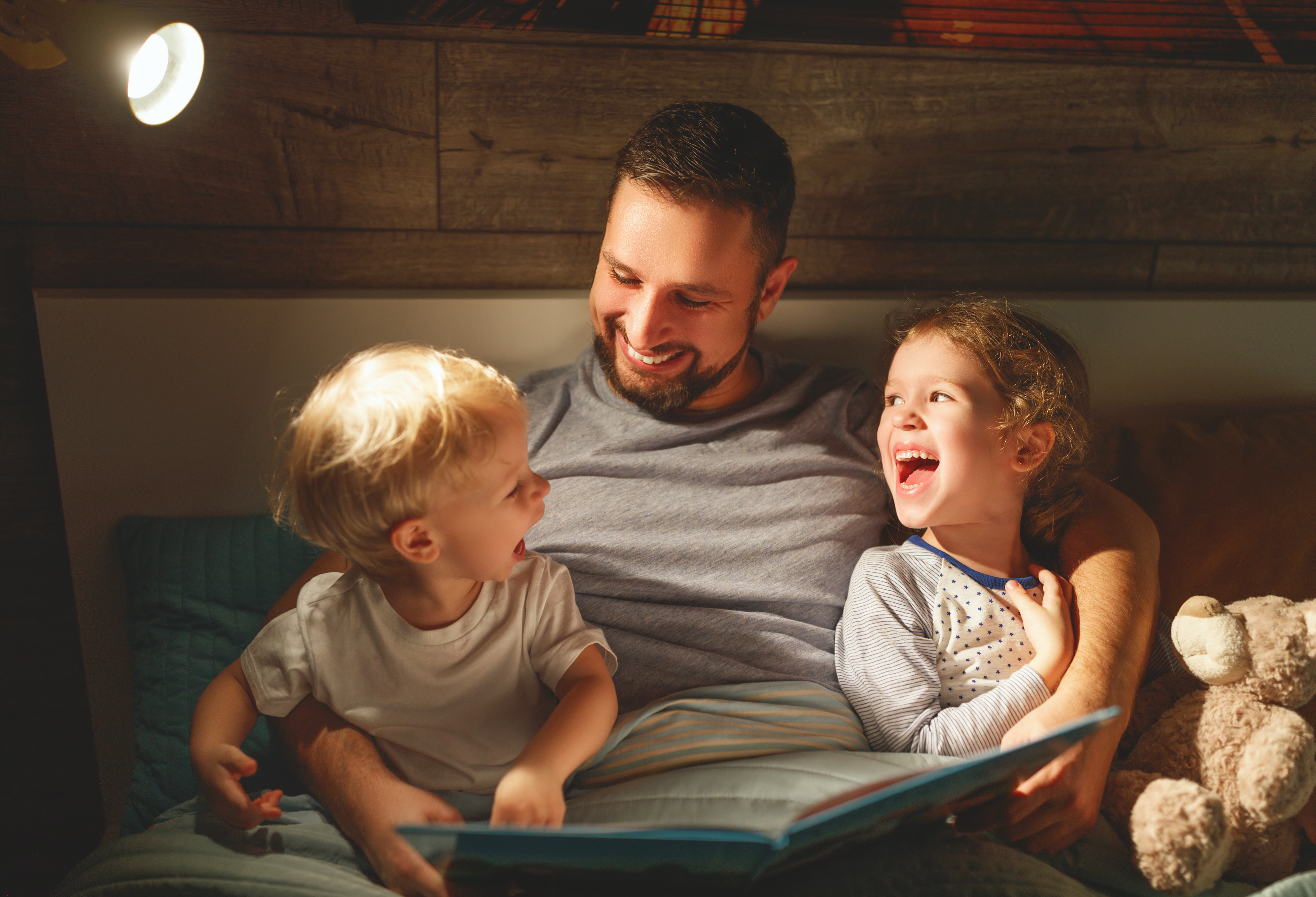
Building an evening routine for kids of different ages
read •

Hi Dr. Laura,
I have difficulty setting a routine with my two children who have a 7 year age difference and are of different sexes. How can I incorporate a
routine that will work for everybody? I grew up without routine and am used to doing things as they come spur of the moment but I want to change
this as I understand it builds self confidence in children. Help!
Routines do indeed help kids feel more secure and confident. They also have lots of other benefits, like helping kids feel more comfortable cooperating (because they don't feel so pushed around), helping kids learn good self-care habits, and developing responsibility. Here's a whole article on why routines are terrific for kids.
Bedtimes are a great place to begin because they include real rewards for your kids -- the time you spend with each of them. You can explain to them that you want to make sure you get "quality time" with each of them every night, which hopefully means they will be more accepting as you introduce the new routine. So let's use bedtimes as our example.
What's the secret of a routine that works for different ages? Consider what each child needs to do each evening, because kids of different ages do have different needs. There may be some activities your kids can do together, but because they are different ages, they will also be doing different things at some points. The good news, though, is that your family as a whole can still have a routine.
How do you figure out your desired routine? Start by deciding what time you want each child in bed. You shouldn't have to wake them up in the morning.
If you do, then it means they aren't getting enough sleep. So keep moving bedtime earlier until they wake up by themselves in the morning. Once you have your target bedtime for each child, count backwards, thinking about what each of them will be doing at each point in time, and write it down.
Then talk with your kids about the routine. What do they think? Have you forgotten anything? Discussing the routine with kids helps them "own" the routine
and reduces power struggles. Give them as much choice as possible.
Finally, print your new schedule out and post a copy on the bathroom door near their bedrooms, and another copy on the refrigerator. Add photos of your kids doing each activity. Most kids like to be involved in taking the photos and gluing them on the schedule, which again makes it "their schedule" instead of just "your schedule."
Your family schedule might look something like this.
6pm-6:30pm- Family Dinner
6:30pm-6:45pm- Everyone clears the table together so there can then be five minutes of "roughhousing. " Any physical activity that gets kids giggling will reduce the level of stress hormones in their bloodstreams and make it easier for them to fall asleep. (Just don't do this too close to "lights out " or they'll be too revved up.) Laughing with you also helps them connect with you, so they're more cooperative and can handle you turning your attention to getting a sibling to bed. And laughing with each other helps siblings bond.
6:45pm- 7:15pm
Bathtime for the three year old, followed by brushing teeth. During this time, you'll need to find something for your older child to do, and to check
in frequently. This is usually a good wind-down time for your older child to play quietly in his room, after he has packed his backpack for the next
day. TV and games are a bad idea because screens (including phones and ipads) reduce melatonin in the bloodstream, which is important to help your
child relax and move toward sleep. It's much better if homework is already completed before dinner, but if not, then this is the time to complete it,
if he can do it relatively independently. Otherwise, he'll need to do it on the floor outside the bathroom while you bathe the little one!
7:15pm-7:40pm
- Ten year old showers, brushes teeth, pjs, sets out clothes and packed backpack for tomorrow. (To remember his list, he will probably need a sign on
the wall.)
- Three year old -- Pjs, setting out clothes for tomorrow and story time with you.
7:40pm-8pm
- Ten year old reads in bed.
- Lights out for the three year old. This gives you time to lie with your child for a few minutes in the dark, snuggling, before you extract yourself,
and to do pre-emptive check-ins every few minutes after you leave the room, so your three year old feels safe and can fall asleep. This timing
assumes that your child gets up at 7am, and still naps, so 11 hours of sleep is about right.
8pm- 8:30pm
Your ten year old, presuming he'll be getting up at 7am, still needs ten hours of sleep, so lights need to be off by 8:30pm to give him half an hour
to fall asleep. Use the half hour between 8 and 8:30pm to connect with him. Read him a story -- Yes, even if he can read! It's great bonding, good
for his intellectual development, and more restful for him than reading to himself. Lie on his bed with him and talk about his day. Snuggle, sing a
song, say prayers if that's part of your tradition, and linger for a few minutes after lights out. As Rabbi Sandy Sasso says, in the dark together
is when you see children's souls.
The great things about a bedtime routine like this:
1. You get special time to connect with each child alone, that your kids can count on. This remains important as kids get older, because it gives the ten year old an opportunity to raise difficult issues and feel heard.
2. Each child gets the security of a safe, predictable, routine at bedtime, which studies have shown is associated with better sleep for everyone in the family, as well as happier, more secure, kids.
3. As your kids get older, they learn self care: to bathe themselves and brush their own teeth, because you have helped them develop the habit.
4. Packing a backpack and setting out clothes makes kids more competent and independent by teaching them to think about the next day. This is invaluable, and not just because it makes mornings calmer. It also allows them to suddenly remember things they have forgotten -- that tomorrow they need a change of clothes because the class is painting a mural, or that they forgot about a homework assignment. (Of course, if they remember these things at bedtime frequently, it's a sign that your after-school routine needs some attention!)
5. Having a routine with times attached keeps you from being the bad-guy bedtime cop. It's just the schedule.
6. Having a set bedtime as a youngster helps your kids, once they become teens, to think in terms of how much sleep they need to take good care of their bodies. They are more likely to stay well-rested.
7. You get to check in with each child separately, which really helps if you've been apart all day. You have more chance of hearing what's bothering them. And you get that essential one-on one time with your older child, which keeps you connected at that difficult moment when he's heading into the tween years -- and peer issues can crowd out his relationship with you, even though he desperately needs to stay anchored to you.
8. Bedtime routines that center around baths and reading calm kids and allow them to fall asleep faster so they don't toss and turn. (Many kids say they aren't tired when they are actually restless because they are overly wound-up.) A bedtime routine that allows a child to stay up longer because he is reading creates the habit of reading. If a computer is nearby, most kids won't read. But computers and TV suppress melatonin, the sleep hormone, so kids should definitely not use them in the hour before bed. Reading relaxes kids, allows melatonin to flood their bodies (make sure their lights are not too bright), and is an easy way to support their developing intellect.
Give your new routine a couple of months to get established. Then you'll be ready to tackle mornings, so everyone gets out the door peacefully. You'll
be amazed at how much more smoothly everything runs!




